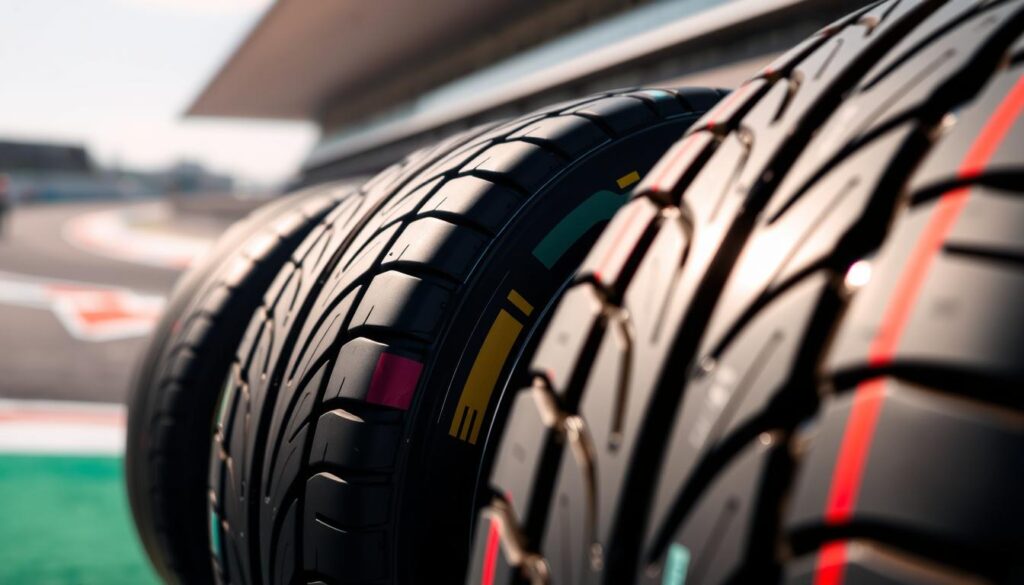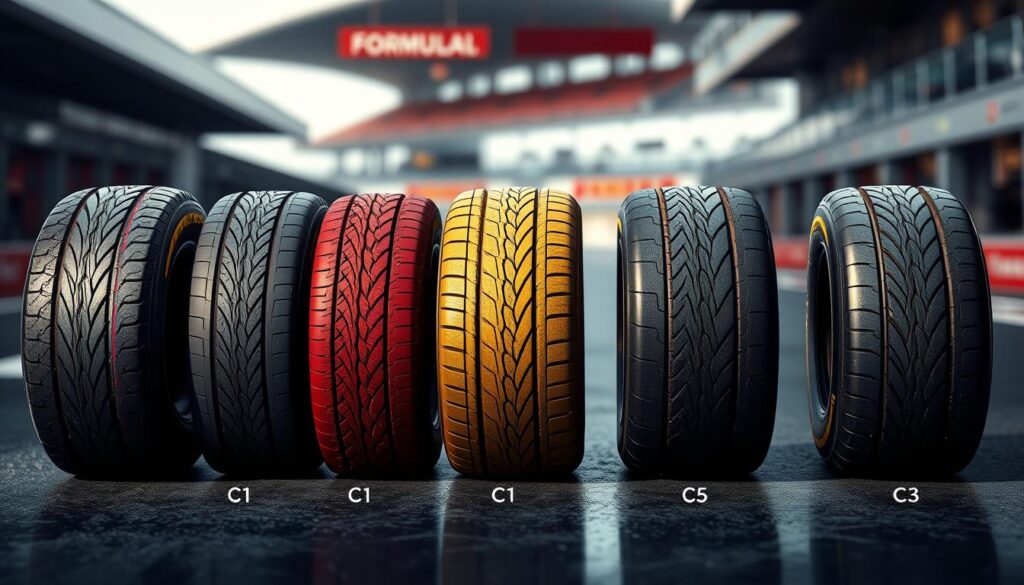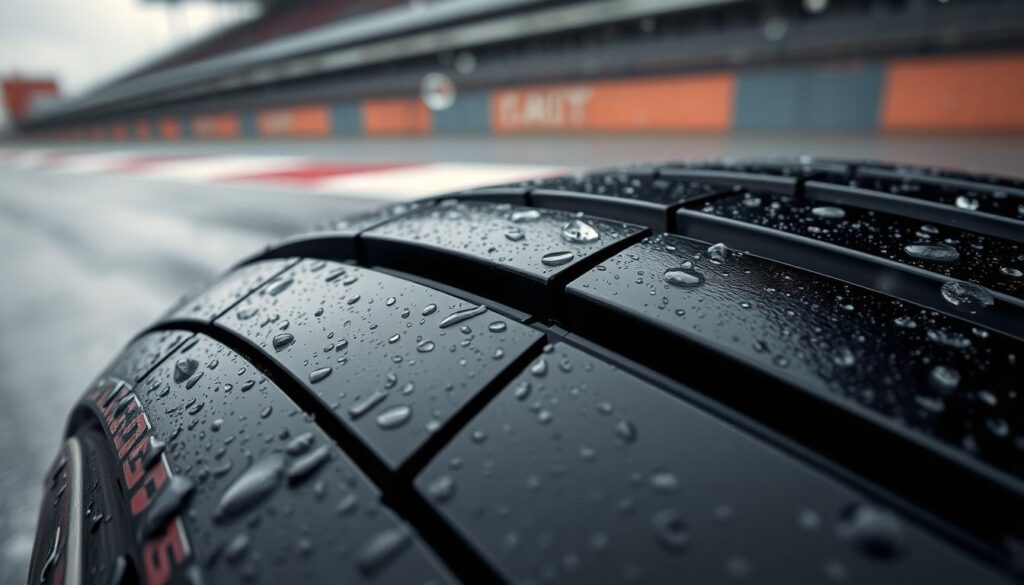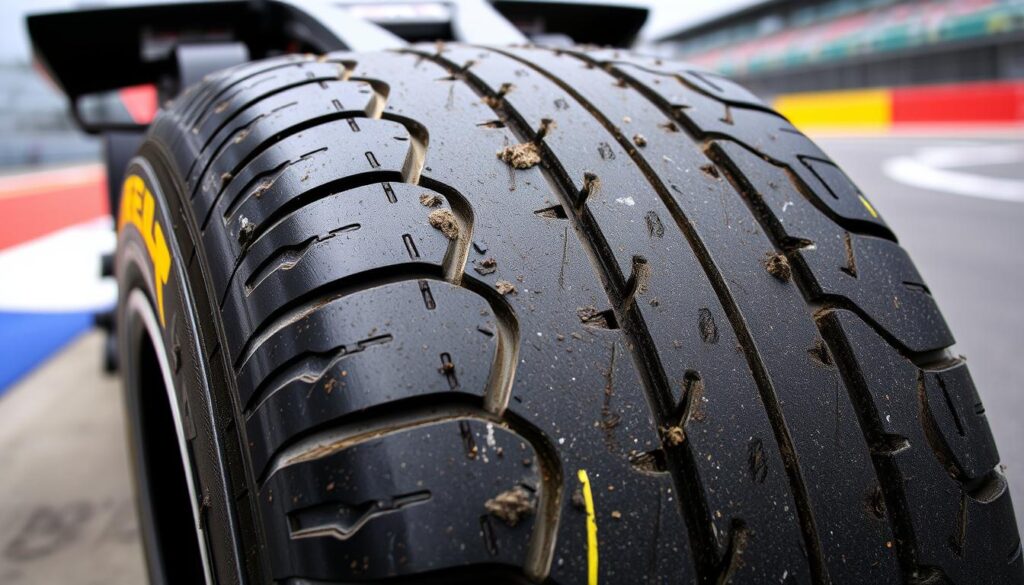I’ve always been fascinated by the role of tyres in Formula 1. They are more than just a way to move the car. They are the base of a team’s racing plan. From the sound of the engines to the thrilling races, tyres are key.
In this guide, we’ll explore F1 tyre types. We’ll look at the compounds used by Pirelli, the official tyre supplier. This will help you understand how they affect the racing experience. Whether you’re new to F1 or a long-time fan, this article will give you a deeper appreciation for the sport.
In This Guide
Understanding F1 Tyre Types and Their Role in Racing
Formula 1 racing is a fast-paced and technologically advanced sport. The choice of tyre compounds is key to a team’s success. Tyre evolution has been shaped by the need for better grip, speed, and durability.
The Evolution of Formula 1 Tyres
Formula 1 tyre technology has evolved a lot over the years. It started with bias-ply tyres and now we have racing slicks. The goal has always been to improve grip and handling.
Impact on Race Performance
The right tyre compounds can greatly affect a car’s performance. Softer tyres give better grip and speed but wear out faster. Harder tyres last longer but don’t grip as well. Finding the right balance is key to a team’s strategy.
Key Components of F1 Tyres
- Tyre construction: The layers and materials that make up the tyre’s structure, designed to provide the desired characteristics.
- Compound composition: The specific blend of rubber and other materials that determine the tyre’s grip, wear, and temperature sensitivity.
- Tread pattern: The design of the tyre’s surface, which can be optimized for dry or wet conditions.
- Sidewall rigidity: The stiffness of the tyre’s sidewall, impacting handling and stability.
Knowing about F1 tyre technology helps us understand the sport’s strategic depth and engineering skill.
Pirelli: The Official F1 Tyre Manufacturer
Pirelli is the only tyre supplier for Formula 1. They are known for their top-notch Pirelli tires. With a long history in motorsports, they bring unmatched skill and new ideas to the top of open-wheel racing.
Pirelli focuses on safety and performance. Their team works hard to make tyres that can handle the high stresses of F1. They offer a variety of tyres, from hard to soft, to give drivers the best grip and durability.
Pirelli has made big strides in tyre tech. They introduced 18-inch wheels and run-flat tyres. They also use real-time tyre data. These innovations make F1 racing exciting and unpredictable every season.
“Pirelli’s focus on innovation and safety has made them an indispensable partner in the world of Formula 1 racing.”
Pirelli stays at the forefront of F1 tyre technology. They provide the high-performance tyres that drivers and teams need to win.

Dry Weather Compounds: From C1 to C5
In Formula 1, tyre compounds are key to team performance and strategy. They range from the hardest C1 to the softest C5. Each has its own traits and uses.
Hard Compound (C1-C2)
The hard compound, C1 or C2, is for high-speed corners and low tyre wear. It’s durable and stable, letting drivers push hard without worrying about wear. It’s often chosen for smooth, high-grip surfaces where wear is less of a worry.
Medium Compound (C3)
The medium compound, C3, balances performance and longevity. It offers good grip, traction, and wear resistance. It’s a versatile choice for many circuit conditions. Teams pick it for a mix of speed and tyre life.
Soft Compound (C4-C5)
The C4 and C5 compounds are very grippy and responsive. These racing slicks provide top traction and performance but wear faster. They’re used for low-speed corners where grip is key. But, managing wear is critical with these tyre compounds.
Teams strategically choose dry weather compounds for each race. They consider the circuit, weather, and race strategy. By picking the right tyre compounds, teams can improve their performance and get ahead on the track.
| Compound | Characteristics | Suitable Conditions |
|---|---|---|
| C1 – C2 (Hard) | Excellent durability and stability, low wear | High-speed circuits, smooth surfaces |
| C3 (Medium) | Balanced performance and wear resistance | Versatile for a range of circuit conditions |
| C4 – C5 (Soft) | Maximum grip and responsiveness, higher wear | Low-speed circuits, where traction is crucial |

“The selection of the right tyre compounds can be the difference between victory and defeat in Formula 1 racing.”
Wet Weather Racing Tyres
When it rains in Formula 1, teams use wet tires to handle the wet track. These tyres are made to grip the road well, even when it’s raining hard. They help keep the cars stable on the circuit.
The main wet weather tyre options are wet tires and intermediate tires. Full wet tires have deep grooves to push water away. This stops the car from sliding and keeps control in heavy rain. They’re the best choice when the track is fully wet.
Intermediate tires are for when the track is damp but not fully wet. They have a less deep tread to balance grip and speed. Drivers use them when the track is drying out, to keep a good pace.
| Tyre Type | Tread Pattern | Optimal Conditions |
|---|---|---|
| Full Wet Tires | Heavily grooved for maximum water displacement | Heavy rain, fully saturated track |
| Intermediate Tires | Intermediate grooves for damp, transitioning conditions | Light rain, damp track, drying conditions |
Choosing between wet tires and intermediate tires is a big decision for teams. It can greatly affect a driver’s performance and the race’s outcome. Knowing how to use these tyres is key to success in wet weather racing in Formula 1.

Understanding Tyre Degradation in Formula 1
In Formula 1, tyre degradation is key to success. The tyres’ performance and life span can greatly affect a driver’s race. It’s a critical factor for teams to manage well.
Factors Affecting Tyre Wear
Several things affect tyre degradation in F1. Driving style, the track, and car setup are all important. Aggressive driving can wear tyres down fast, while smooth driving helps them last longer.
The track’s surface also matters. Rough surfaces can cause tyres to wear out quicker.
Managing Degradation During Races
Teams need a good tyre strategy to deal with tyre degradation. They watch tyre wear closely and plan pit stops to keep performance up. They use different tyre compounds to fit the race’s needs.
Temperature Impact on Performance
Temperature is key for tyre performance. Too cold, and tyres can’t grip well. Too hot, and they degrade fast. Teams adjust settings to keep tyres at the best temperature.

“Tyre management is one of the most crucial aspects of Formula 1 racing. Getting the right balance between performance and durability can be the difference between victory and defeat.”
Race Strategy and Tyre Management
In Formula 1, tyres are key to winning. Choosing the right tyres and when to change them can decide a driver’s success. It’s all about staying ahead by understanding tyre strategy.
Managing tyres well means finding the right balance. Drivers need to watch tyre conditions and track changes. This helps them decide when to pit and which tyres to use. The right strategy can help drivers pass others and stay safe from rivals.
There have been great tyre strategies in F1. For example, Red Bull’s choice to start Max Verstappen on hard tyres at the 2021 Emilia Romagna Grand Prix helped him win. Also, Mercedes’ clever two-stop strategy at the 2020 Eifel Grand Prix led to a 1-2 finish for Lewis Hamilton and Valtteri Bottas.
| Tyre Compound | Typical Pit Stop Strategy | Advantages | Disadvantages |
|---|---|---|---|
| Hard (C1-C2) | 1-stop | Excellent durability, high wear resistance | Lower grip levels, less responsive handling |
| Medium (C3) | 1-stop or 2-stop | Balanced performance, moderate wear | Compromise between grip and durability |
| Soft (C4-C5) | 2-stop or 3-stop | High grip levels, responsive handling | Rapid wear, more pit stops required |
Teams can improve their chances in F1 by smart tyre management. They use different tyres for different needs. Each tyre has its own strengths and weaknesses, requiring careful planning and skill.
The Science Behind F1 Tyre Construction
Formula 1 racing is all about the latest technology. The tyres used in these races are a perfect example. Tyre makers like Pirelli have worked hard to create special compounds and designs. These can handle the extreme conditions of F1 racing.
Tyre Architecture
An F1 tyre is made up of many layers, each with its own job. The carcass is the innermost part. It keeps the tyre strong and its shape intact under heavy loads. The belt layer outside the carcass adds stability and makes the tyre more responsive.
The tread is the outermost layer. It touches the track. Tyre makers design the tread pattern and compound to improve grip, traction, and wear. They do this for different racing conditions.
Compound Development
Finding the right tyre compound for F1 racing is a big challenge. Tyre makers like Pirelli do lots of research and testing. They mix different materials and test them in both simulated and real racing environments.
The goal is to make a tyre that performs well lap after lap. It must also handle the high heat, forces, and wear of F1 racing.
Testing Procedures
- Rigorous laboratory testing: Tyre makers test their compounds in many ways. This includes material analysis, wear simulations, and performance tests under controlled conditions.
- Virtual simulations: They use computer models to predict how tyre compounds will behave in different racing situations. This helps them make quick changes and improvements.
- On-track testing: They test prototype tyres on real race tracks. Drivers and engineers give feedback to make the final product better.
This detailed approach to tyre development helps Pirelli and other tyre makers. They can give F1 teams the best tyres for each race. This lets the teams perform at their best while staying safe and reliable.
Pit Stop Tactics and Tyre Changes
In Formula 1 racing, pit stops are key to success. The speed and precision of your pit crew can change the race. Teams work hard to shave seconds off each stop, gaining an edge.
Your tyre strategy is also crucial. Deciding when to pit and which tyres to use can affect your position. Teams study data and weather to make the best decisions. The right choice can lead to victory, while the wrong one can drop you in the standings.
Being good at pit stops and tyre management is vital for Formula 1 teams. Quick decisions and constant competition make flawless pit stops and smart tyre strategies essential. These skills are what separate champions from contenders.

